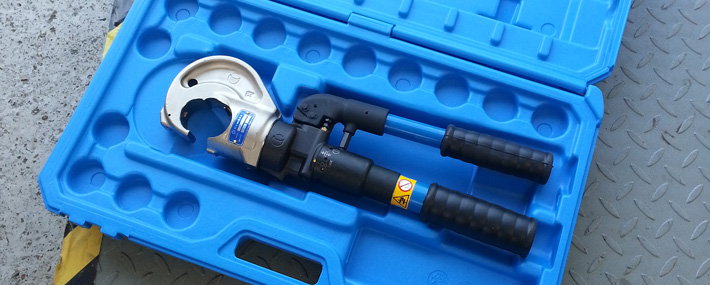Whether you are buying or hiring a hydraulic cable crimper or cutter, following these guidelines helps prevent more than just tool failure and time lost on site.
An example of this is incorrect crimping, which can lead to a number of issues with lug failure. If the tool is unable to properly crimp the lug to the cable, then the air pockets within the core can cause an increase in resistance leading to overheating and potentially a fire. The following images show an installation where an electrical lug was installed with an uncalibrated tool with inadequate pressure. This led to the fire bridge being called, the building being evacuated and losing 2 hours of operating time.


Typically, hydraulic tools are naturally robust given nature of the tasks they are designed for, however, we always recommend you ensure your tools are in date in terms of calibration and the on-site team is reminded about the importance of pre-use checks and tests, as well as demonstrating the results if a crimp is not undertaken carefully.
Our hydraulic tool maintenance guide gives you a few simple steps that can help avoid tool failure, hydraulic oil leakage and head jamming.
General Maintenance
When you hire or purchase a tool you should also check its condition as soon as you receive it, making sure there are no defects that could impact performance. Usually, tools distributed from reputable companies are calibrated, tested and guaranteed before delivery. However, checking yourself should be the final line of defence.
All tools we supply come with full operation instructions, these instructions should be followed as not only do they help achieve the best cut or crimp, they also keep the tool within safe operating conditions. Keeping to these guidelines will ensure the tool works to its best capacity as well as allowing it to maintain this performance throughout its operational life.
How often should I calibrate my crimper/cutter?
Whenever you hire or first purchase a hydraulic Cembre cutting or crimping tool from ETS, we fully test and calibrate your tool before delivery, supplying a calibration certificate with the tool. For short to medium term hires it is unlikely that the tool will need calibration while on its hire period. However, with long term rental and purchasing a tool, knowing when to calibrate your tool is important.
It is recommended that you get your hydraulic tool calibrated every 12 months. Calibration will test the pressure of your tool using a manometer. The pressure measurement test will make sure the tool meets the recommended level of pressure to enable the correct crimping or cutting operation. If the tool does not meet the required minimum pressure, it needs to be sent to the manufacturer for repair. We can carry out full calibration services for Cembre tools, please contact us for more information.
How to correctly store a hydraulic tool
All our Cembre hydraulic tools are supplied with protective storage cases, with enough room to store the tool or head and a number of die sets. These cases help keep the tool safe from damage on-site as well as providing an easy way to transport the tool to, from and around a project.
We recommend keeping the tool within the heavy-duty protective case while not in use as not only does it protect the tool from damage but also keeps harmful dirt and greases away from clogging the mechanisms.
Lifespan of a well maintained tool
A faulty tool is not just costly if you need to purchase a replacement, it can also be time consuming to organise collection and delivery of replacement tooling. Leading to increased time on site and a reduction in productivity, which could have a ripple effect down the line if essential work is reliant on the crimping or cutting of cables.
We offer a full 12 month warranty with all Cembre hydraulic tools we hire and sell. Although following these tool care and maintenance guidelines will enable your tool to work far beyond this period, reduce tool failure downtime and extend its operational life-span to its maximum potential.
If you found this article helpful or interesting, please share it!














